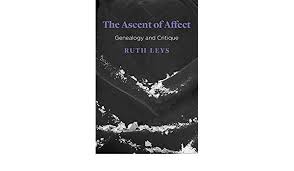Clive Barnett and many others at nonsite:
 The Ascent of Affect turns on the contention that what is most at stake across various intellectual debates, from the humanities to neurosciences, is the conceptual status and normative value of the idea of intentionality, that is, of the idea that there is a relationship between “the mind” and things, or properties, or states of affairs of some sort. The question of how to understand the “aboutness” of mental states the long-standing theme of philosophical debates about intentionality.6 Leys structures her discussion around a conundrum which is, she suggests, pivotal to a whole series of contemporary debates in the philosophy of mind, neuroscience, psychology, as well as traditions of critical social thought. The conundrum, she proposes, arises from the conflict between two equally compelling observations. On the one hand, there is the long-standing concern with making sense of the intentionality of the emotions, understood in terms of “the fact or idea that emotions are directed at cognitively apprehended objects and are sensitive to ‘reasons.’”7 On the other hand, emotions also appear to be common to both humans and non-human animals. Often enough, the latter observation is used to refute any sense of the intentionality of emotions, as if the idea of intentionality necessitated a highly rational, linguistic, cognitive view of reasonable action. The apparent incompatibility between holding to the intentionality of emotions and acknowledging the continuities between human and non-human rationality underwrites the divide between cognitivists–who remain keen to investigate intentionality but find it difficult to acknowledge emotions in nonhuman animals–and noncognitivists–who emphasise “the importance of bodily changes and subpersonal processes in the emotions but are seen to have difficulty explaining how it is that emotions have meaning.”
The Ascent of Affect turns on the contention that what is most at stake across various intellectual debates, from the humanities to neurosciences, is the conceptual status and normative value of the idea of intentionality, that is, of the idea that there is a relationship between “the mind” and things, or properties, or states of affairs of some sort. The question of how to understand the “aboutness” of mental states the long-standing theme of philosophical debates about intentionality.6 Leys structures her discussion around a conundrum which is, she suggests, pivotal to a whole series of contemporary debates in the philosophy of mind, neuroscience, psychology, as well as traditions of critical social thought. The conundrum, she proposes, arises from the conflict between two equally compelling observations. On the one hand, there is the long-standing concern with making sense of the intentionality of the emotions, understood in terms of “the fact or idea that emotions are directed at cognitively apprehended objects and are sensitive to ‘reasons.’”7 On the other hand, emotions also appear to be common to both humans and non-human animals. Often enough, the latter observation is used to refute any sense of the intentionality of emotions, as if the idea of intentionality necessitated a highly rational, linguistic, cognitive view of reasonable action. The apparent incompatibility between holding to the intentionality of emotions and acknowledging the continuities between human and non-human rationality underwrites the divide between cognitivists–who remain keen to investigate intentionality but find it difficult to acknowledge emotions in nonhuman animals–and noncognitivists–who emphasise “the importance of bodily changes and subpersonal processes in the emotions but are seen to have difficulty explaining how it is that emotions have meaning.”
more here.
